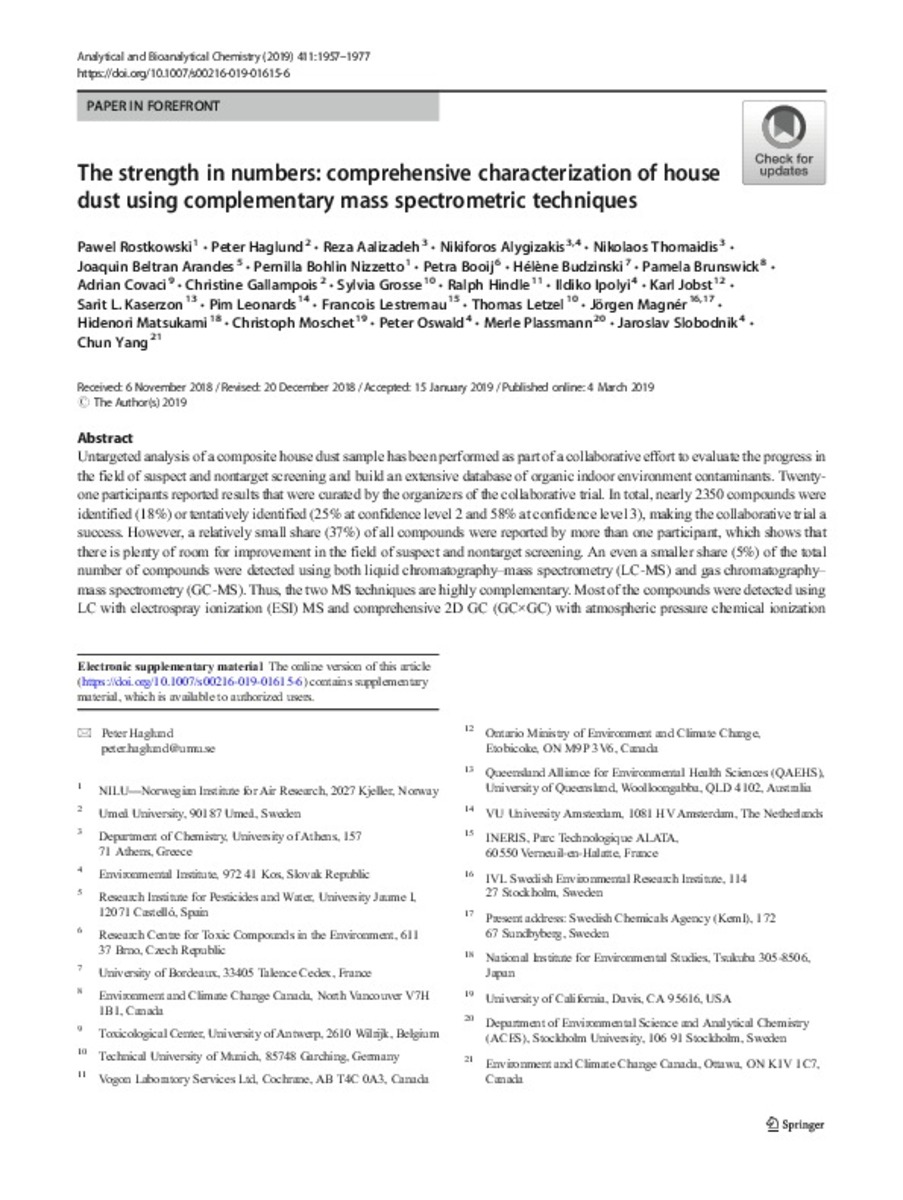Mostrar el registro sencillo del ítem
The strength in numbers: comprehensive characterization of house dust using complementary mass spectrometric techniques
| dc.contributor.author | Rostkowski, Pawel | |
| dc.contributor.author | Haglund, Peter | |
| dc.contributor.author | Aalizadeh, Reza | |
| dc.contributor.author | Alygizakis, Nikiforos | |
| dc.contributor.author | Thomaidis, Nikolaos | |
| dc.contributor.author | Beltran Arandes, Joaquin | |
| dc.contributor.author | Bohlin-Nizzetto, Pernilla | |
| dc.contributor.author | Booij, Petra | |
| dc.contributor.author | Budzinski, Hélène | |
| dc.contributor.author | Brunswick, Pamela | |
| dc.contributor.author | Covaci, Adrian | |
| dc.contributor.author | Gallampois, Christine | |
| dc.contributor.author | Grosse, Sylvia | |
| dc.contributor.author | Hindle, Helen | |
| dc.contributor.author | Ipolyi, Ildiko M. | |
| dc.contributor.author | Jobst, Karl | |
| dc.contributor.author | Kaserzon, Sarit | |
| dc.contributor.author | Leonards, Pim | |
| dc.contributor.author | Lestremau, Francois | |
| dc.contributor.author | Letzel, Thomas | |
| dc.contributor.author | Magner, Jorgen | |
| dc.contributor.author | Matsukami, Hidenori | |
| dc.contributor.author | Moschet, Christoph | |
| dc.contributor.author | Oswald, Peter | |
| dc.contributor.author | Plassmann, Merle | |
| dc.contributor.author | Slobodnik, Jaroslav | |
| dc.contributor.author | Yang, Chun | |
| dc.date.accessioned | 2019-05-15T10:00:50Z | |
| dc.date.available | 2019-05-15T10:00:50Z | |
| dc.date.issued | 2019-04 | |
| dc.identifier.citation | ROSTKOWSKI, Pawel, et al. The strength in numbers: comprehensive characterization of house dust using complementary mass spectrometric techniques. Analytical and bioanalytical chemistry, 2019, Vol. 411, no 10, p. 1-21 | ca_CA |
| dc.identifier.issn | 1618-2642 | |
| dc.identifier.issn | 1618-2650 | |
| dc.identifier.uri | http://hdl.handle.net/10234/182496 | |
| dc.description.abstract | Untargeted analysis of a composite house dust sample has been performed as part of a collaborative effort to evaluate the progress in the field of suspect and nontarget screening and build an extensive database of organic indoor environment contaminants. Twenty-one participants reported results that were curated by the organizers of the collaborative trial. In total, nearly 2350 compounds were identified (18%) or tentatively identified (25% at confidence level 2 and 58% at confidence level 3), making the collaborative trial a success. However, a relatively small share (37%) of all compounds were reported by more than one participant, which shows that there is plenty of room for improvement in the field of suspect and nontarget screening. An even a smaller share (5%) of the total number of compounds were detected using both liquid chromatography–mass spectrometry (LC-MS) and gas chromatography–mass spectrometry (GC-MS). Thus, the two MS techniques are highly complementary. Most of the compounds were detected using LC with electrospray ionization (ESI) MS and comprehensive 2D GC (GC×GC) with atmospheric pressure chemical ionization (APCI) and electron ionization (EI), respectively. Collectively, the three techniques accounted for more than 75% of the reported compounds. Glycols, pharmaceuticals, pesticides, and various biogenic compounds dominated among the compounds reported by LC-MS participants, while hydrocarbons, hydrocarbon derivatives, and chlorinated paraffins and chlorinated biphenyls were primarily reported by GC-MS participants. Plastics additives, flavor and fragrances, and personal care products were reported by both LC-MS and GC-MS participants. It was concluded that the use of multiple analytical techniques was required for a comprehensive characterization of house dust contaminants. Further, several recommendations are given for improved suspect and nontarget screening of house dust and other indoor environment samples, including the use of open-source data processing tools. One of the tools allowed provisional identification of almost 500 compounds that had not been reported by participants. Open image in new window | ca_CA |
| dc.format.extent | 21 p. | ca_CA |
| dc.format.mimetype | application/pdf | ca_CA |
| dc.language.iso | eng | ca_CA |
| dc.publisher | Springer | ca_CA |
| dc.relation.isPartOf | Analytical and Bioanalytical Chemistry, 2019, vol. 411, no 10 | ca_CA |
| dc.rights | Atribución 4.0 Internacional | * |
| dc.rights.uri | http://creativecommons.org/licenses/by-sa/4.0/ | * |
| dc.subject | house dust | ca_CA |
| dc.subject | suspect and nontarget analysis | ca_CA |
| dc.subject | collaborative trial | ca_CA |
| dc.subject | complementary analytical techniques | ca_CA |
| dc.subject | mass spectrometry | ca_CA |
| dc.title | The strength in numbers: comprehensive characterization of house dust using complementary mass spectrometric techniques | ca_CA |
| dc.type | info:eu-repo/semantics/article | ca_CA |
| dc.identifier.doi | https://doi.org/10.1007/s00216-019-01615-6 | |
| dc.rights.accessRights | info:eu-repo/semantics/openAccess | ca_CA |
| dc.relation.publisherVersion | https://link.springer.com/article/10.1007/s00216-019-01615-6 | ca_CA |
| dc.contributor.funder | The NORMAN network is thanked for acting as the supporting organization of the study and the research group of Prof. Miriam Diamond, University of Toronto, Canada University of Toronto for the donation of the dust sample. | ca_CA |
| dc.type.version | info:eu-repo/semantics/publishedVersion | ca_CA |
Ficheros en el ítem
Este ítem aparece en la(s) siguiente(s) colección(ones)
-
IUPA_Articles [310]








